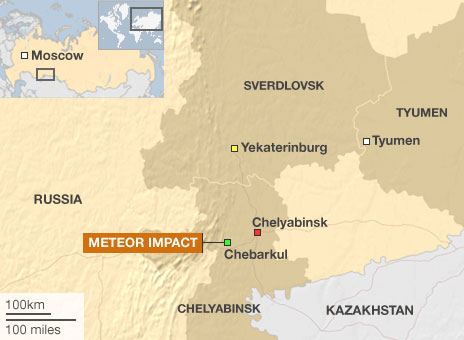Chelyabinsk
The city is located almost in the central part of the continent of Eurasia. The western foothills of the Ural mountains gradually pass in the East Europe plain while the eastern slopes abruptly go down, adjoining to flat West Siberian lowland. In the southern Urals it is possible to find all the natural-landscape zones of Russia. In the upper parts of the mountains there are zones of tundra and forest-tundra, then taiga, mixed and broad-leaved forests. Further to the south there are zones of forest-steppe, steppe and semi-desert. The geographic location, variety of natural landscapes and climatic features give the Chelyabinsk area its unique shape.

If you visit the city Chelyabinsk, we are glad to offer you some excursions in Chelyabinsk and its environs. All of these programmes start in Chelyabinsk. For some impressions from our guests who have visited the Urals, please click here
You can find map of Chelyabinsk here
Flag of Chelyabinsk region
The mountain rivers of the area are picturesque - beginning on the slopes, they run deeply into mountain valleys or cut through mountain ridges. Rocky river banks, swift flowing currents, stony river-channels and transparent water attract many tourists in spring and summer. Geographers consider the Chelyabinsk area as “lake-land”, as there are more than three thousand lakes with depths reaching 30-40 metres. Many lakes in the steppe zones have a higher level of mineralization.
Here can be found more than 60 species of mammals and 232 species of birds. Wolves, foxes, elks, roes, squirrels, moles, hedgehogs, beavers, martens, minks, pole-cats, badgers, rodents, ducks, geese, cranes, woodpeckers,seagulls, chaffinches are widely distributed, and to a lesser extent - bears, lynxes, spotty deers, wood-grouses and swans can be found.
In the mountains there are specially protected territories, including the world famous "mineralogical paradise" - the state Ilmensky reserve and the national parks "Taganai" and "Zyuratkul". The natural landscape and historical-archeological museum - reserve "Arkaim" recognized as the major archeological discovery of the 20th century is located in the south of the region. A few years ago the Sikiyaz-Tamak cave complex, which includes 43 differing in size and shape and karst cavities, was found.
Lovers of fascinating excursions, contemporary walks, different active tours (rafting, trekking, caving trips and others) and judges of rock paintings of the Stone Age (“Ignatyevskaya cave”) galleries and achievements of the Ural gun makers – in fact admirers of all forms of art will find something new and interesting traveling in the Chelyabinsk area of the southern Urals.
In ancient times, in the now territory of the Chelyabinsk Region, the ancestors of Bashkir and Kazakhs lived. In the 13th century these grounds were under the control of the Mongol-Tatars. Russian people appeared here in the 16th century and by the end of the 17th, the territory came under the constant control of Russia, becoming a part of the Russian Empire in the 18th century.
Chelyabinsk was founded in 1736 as a Russian fortress at Cheljaba, on the right bank of the river Miass. It was part of fortified line, built for the protection of Iset province. Economic development of the city went slowly because of competition with other trade centres of the southern Urals. From 1781 Chelyabinsk was part of the Ekaterinburg region becoming a city in 1791. From 1796 year it was the capital of the Orenburg province. At the end of the 19th century, in conjunction with the construction of the Trans-Siberian railway and the railway to Ekaterinburg, Chelyabinsk became a large transport and trading (exporting bread from western Siberia) centre of the Urals. At the end of the 19th to the beginning of the 20th centuries, the tea and bread trade and flour milling developed greatly in Chelyabinsk. Enterprises for the processing of agricultural raw materials also appeared. During the period 1919-23 Chelyabinsk was the centre of the Chelyabinsk province - then a part of the Urals and from 1934 it was the capital of the Chelyabinsk area. During WW 2 about 60 military production plants were relocated to Chelyabinsk.
The Chelyabinsk area is one of the most advanced industrial areas of Russia - the main branches of black and nonferrous metallurgy, mechanical engineering, metal works and the chemical industry are located here. Extraction of iron ore, magnesite, graphite, and brown coal is carried out and the large Karabash copper and Verkhnij Ufalej nickel mines are working. There are plants for transport and agricultural mechanical engineering, machine tool construction and instrument making.
Throughout the Chelyabinsk area there are numerous enterprises dealing with the processing of food. Spring wheat, potatoes, vegetables, watermelons and melons are grown. Large horned livestock, sheep, goats, pigs and poultry are raised. There is also a building construction material industry.
Rail transport carries the bulk of passenger and freight throughout the region with the main lines being: Ufa - Chelyabinsk - Kurgan, Ufa - Magnitogorsk - Kartaly, Chelyabinsk - Kartaly – Orsk and Chelyabinsk - Ekaterinburg. A well advanced network of highways serve the area, with air transport also playing an important role.  
|

